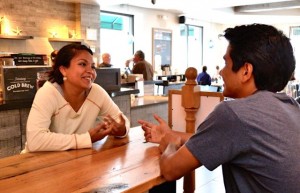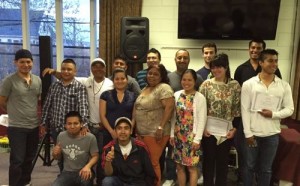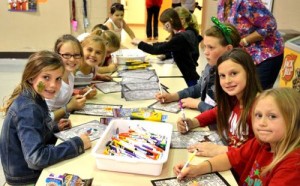Third-graders Christopher Herrera-Avila and Kiara Rivero-Bautista celebrate the end of the school year with a Mexican-themed fiesta at Ocean City Primary School.
Statistics show that enrollment at Ocean City Primary School (OCPS) is steadily on the rise, and the uptick is largely attributable to a growing Hispanic population.
During the 2013-14 school year, nearly 1-in-5 OCPS students (18.5%) was of Hispanic origin, a 4% increase over the 2011-2012 school year. Over the same three-year span the percentage of students classified as white and black decreased at the school, despite an overall enrollment gain of 35 children.
The data is compiled by the New Jersey Department of Education each year and released in the form of a "School Performance Report.” In addition to providing information on standardized test scores and graduation rates, the report — pursuant to New Jersey’s No Child Left Behind flexibility request — tracks ethnic subgroups, in the hopes of closing racial and socioeconomic achievement gaps.
Although there are approximately 40 “English Language Learners” (ELLs) currently enrolled in the district, there are many more Hispanic students who never needed, or no longer qualify for, services.
To that end, OCPS Spanish teacher Paola Neff says the numbers don’t tell the whole story, even within the district’s “English as a Second Language” (ESL) program itself.
“Of the children we have here for ESL, the vast majority were born in the United States. They didn’t immigrate here. They are American citizens, who have heard English their entire lives,” she says. “It’s not as though they are entering the Primary School not knowing a word of English, which is the way it often was 10 or 15 years ago.”

Nelly Rivero and her brother Pablo at Starbucks in Ocean City.
The “way it was” is now just a distant memory for Nelly Rivero, who arrived at OCPS from Mexico in 2004 as a 7-year-old. “I knew the basics, like ‘my name is’ and ‘hello,’ but not much else,” she recalls.
On her first day of second grade, Rivero felt lost – literally.
“I didn’t know where I was supposed to go, or where I was supposed to be,” she says. “It was tough.”
In just a matter of weeks, however, the OCHS senior will graduate with a “B” average and someday soon, she hopes to attend college.
Rivero, who also helps run a local business with her father, attributes her bright future — in part — to the ESL instruction she received in her earliest days at OCPS. “It was a great experience,” she says. “It helped me understand the people around me, it helped me to make friends and just to feel successful.”
Upon exiting the ESL program as a fourth grader, Rivero says she was able to approach school with a new-found confidence.
“That’s really when I knew: I could do this,” she says.
“It’s like getting your driver’s license,” she continues. “You don’t have a learner’s permit anymore and you’re certain, at that point, that you know how to drive. When I graduated from ESL, that’s how I felt. It was so proud. Because in that moment I knew I could finally speak for myself. Nobody else would ever have to speak for me again.”
District-wide ESL teacher Ashley Schmid says that incoming ELLs are offered a “high intensity” ESL program, with beginners receiving two sessions of ESL and attending basic level classes until they can be transitioned to “bridging.” Services are then gradually scaled back until total immersion in a mainstream classroom can take place.
But even after passing the English Proficiency Exam, ELLs can be monitored by the district for up to three years. “This enables us to keep an eye on them, and catch them if they start to flounder,” Schmid says.
Beyond academics, ELLs are encouraged to join various clubs and groups as well as offered an opportunity to work in the Raider Retailers school store at OCHS. The latter option not only encourages ELLs to use their math skills, Schmid says it also provides a chance for “authentic practice with conversation.”
The district’s commitment to the well-being of its ELLs is perhaps never more apparent than at Hispanic Community Night, where Spanish-speaking students and their families meet school administrators, learn about extracurricular activities and get help filling out sports physicals and other forms – all in their native language.
“Some of the families may be nervous to ask questions during ‘Back to School’ nights,” Schmid says, “so we wanted to reach out to them, and give them a night with no pressure.”

2015 graduates of St. Peter’s ESL program
At Hispanic Community Night attendees are also given information on various community-based resources, including free ESL classes at St. Peter’s of Ocean City (501 E. 8
th St.).
In May, the church celebrated 18 new graduates according to retired OCHS French/English teacher Judy Rinck, who has overseen the decade-old program since 2012. “Our students are so dedicated,” Rinck says. “They attend class whenever they are able, whether in foul weather or after a long day of work.”
St. Peter’s differs from other local ESL programs in that it offers both a beginner and intermediate class, with instruction by two teachers who are assisted by aides. The goal during class is “total immersion” in English according to Rinck, with a focus on each student’s unique job interests.
“We help them with the things they need help with,” she explains. “If they are interested in landscaping, then we teach them landscaping terms. If they need to learn restaurant terms, then we start with restaurant terms.”
At graduation each student is given a chance to tell their story in what is often an emotional scene.
“Some will talk about how difficult it was to come here and what they had to go through,” Rinck says. “But at the same time, most of them still love their home country. They just don’t have opportunities there, like they do here.”

Third graders Bria Condella, Reagan DeVlieger, Mia Gallagher, Ella Quintin, Anna Stamm, Lola Bourgeois, Schyler MacMichael and Ava Pitman enjoying crafts at the recent OCPS fiesta.
Each graduating class “is truly interested in learning to speak English,” Rinck adds. “They wouldn’t show up, week after week, if they weren’t. And while they want to be able to make a living and support their family, they also want very much to fit in in our community.”
Neff – who in May hosted the OCPS annual Mexican fiesta for outgoing third-graders – says the young Hispanic population at OCPS feels much the same way.
“The Spanish-speaking students in my class want to blend in,” Neff says. “Kids are kids. All kids want to feel special. They just don’t want to feel different.”
 Nelly Rivero and her brother Pablo at Starbucks in Ocean City.
The “way it was” is now just a distant memory for Nelly Rivero, who arrived at OCPS from Mexico in 2004 as a 7-year-old. “I knew the basics, like ‘my name is’ and ‘hello,’ but not much else,” she recalls.
On her first day of second grade, Rivero felt lost – literally.
“I didn’t know where I was supposed to go, or where I was supposed to be,” she says. “It was tough.”
In just a matter of weeks, however, the OCHS senior will graduate with a “B” average and someday soon, she hopes to attend college.
Rivero, who also helps run a local business with her father, attributes her bright future — in part — to the ESL instruction she received in her earliest days at OCPS. “It was a great experience,” she says. “It helped me understand the people around me, it helped me to make friends and just to feel successful.”
Upon exiting the ESL program as a fourth grader, Rivero says she was able to approach school with a new-found confidence.
“That’s really when I knew: I could do this,” she says.
“It’s like getting your driver’s license,” she continues. “You don’t have a learner’s permit anymore and you’re certain, at that point, that you know how to drive. When I graduated from ESL, that’s how I felt. It was so proud. Because in that moment I knew I could finally speak for myself. Nobody else would ever have to speak for me again.”
District-wide ESL teacher Ashley Schmid says that incoming ELLs are offered a “high intensity” ESL program, with beginners receiving two sessions of ESL and attending basic level classes until they can be transitioned to “bridging.” Services are then gradually scaled back until total immersion in a mainstream classroom can take place.
But even after passing the English Proficiency Exam, ELLs can be monitored by the district for up to three years. “This enables us to keep an eye on them, and catch them if they start to flounder,” Schmid says.
Beyond academics, ELLs are encouraged to join various clubs and groups as well as offered an opportunity to work in the Raider Retailers school store at OCHS. The latter option not only encourages ELLs to use their math skills, Schmid says it also provides a chance for “authentic practice with conversation.”
The district’s commitment to the well-being of its ELLs is perhaps never more apparent than at Hispanic Community Night, where Spanish-speaking students and their families meet school administrators, learn about extracurricular activities and get help filling out sports physicals and other forms – all in their native language.
“Some of the families may be nervous to ask questions during ‘Back to School’ nights,” Schmid says, “so we wanted to reach out to them, and give them a night with no pressure.”
Nelly Rivero and her brother Pablo at Starbucks in Ocean City.
The “way it was” is now just a distant memory for Nelly Rivero, who arrived at OCPS from Mexico in 2004 as a 7-year-old. “I knew the basics, like ‘my name is’ and ‘hello,’ but not much else,” she recalls.
On her first day of second grade, Rivero felt lost – literally.
“I didn’t know where I was supposed to go, or where I was supposed to be,” she says. “It was tough.”
In just a matter of weeks, however, the OCHS senior will graduate with a “B” average and someday soon, she hopes to attend college.
Rivero, who also helps run a local business with her father, attributes her bright future — in part — to the ESL instruction she received in her earliest days at OCPS. “It was a great experience,” she says. “It helped me understand the people around me, it helped me to make friends and just to feel successful.”
Upon exiting the ESL program as a fourth grader, Rivero says she was able to approach school with a new-found confidence.
“That’s really when I knew: I could do this,” she says.
“It’s like getting your driver’s license,” she continues. “You don’t have a learner’s permit anymore and you’re certain, at that point, that you know how to drive. When I graduated from ESL, that’s how I felt. It was so proud. Because in that moment I knew I could finally speak for myself. Nobody else would ever have to speak for me again.”
District-wide ESL teacher Ashley Schmid says that incoming ELLs are offered a “high intensity” ESL program, with beginners receiving two sessions of ESL and attending basic level classes until they can be transitioned to “bridging.” Services are then gradually scaled back until total immersion in a mainstream classroom can take place.
But even after passing the English Proficiency Exam, ELLs can be monitored by the district for up to three years. “This enables us to keep an eye on them, and catch them if they start to flounder,” Schmid says.
Beyond academics, ELLs are encouraged to join various clubs and groups as well as offered an opportunity to work in the Raider Retailers school store at OCHS. The latter option not only encourages ELLs to use their math skills, Schmid says it also provides a chance for “authentic practice with conversation.”
The district’s commitment to the well-being of its ELLs is perhaps never more apparent than at Hispanic Community Night, where Spanish-speaking students and their families meet school administrators, learn about extracurricular activities and get help filling out sports physicals and other forms – all in their native language.
“Some of the families may be nervous to ask questions during ‘Back to School’ nights,” Schmid says, “so we wanted to reach out to them, and give them a night with no pressure.”

 Third graders Bria Condella, Reagan DeVlieger, Mia Gallagher, Ella Quintin, Anna Stamm, Lola Bourgeois, Schyler MacMichael and Ava Pitman enjoying crafts at the recent OCPS fiesta.
Each graduating class “is truly interested in learning to speak English,” Rinck adds. “They wouldn’t show up, week after week, if they weren’t. And while they want to be able to make a living and support their family, they also want very much to fit in in our community.”
Neff – who in May hosted the OCPS annual Mexican fiesta for outgoing third-graders – says the young Hispanic population at OCPS feels much the same way.
“The Spanish-speaking students in my class want to blend in,” Neff says. “Kids are kids. All kids want to feel special. They just don’t want to feel different.”
Third graders Bria Condella, Reagan DeVlieger, Mia Gallagher, Ella Quintin, Anna Stamm, Lola Bourgeois, Schyler MacMichael and Ava Pitman enjoying crafts at the recent OCPS fiesta.
Each graduating class “is truly interested in learning to speak English,” Rinck adds. “They wouldn’t show up, week after week, if they weren’t. And while they want to be able to make a living and support their family, they also want very much to fit in in our community.”
Neff – who in May hosted the OCPS annual Mexican fiesta for outgoing third-graders – says the young Hispanic population at OCPS feels much the same way.
“The Spanish-speaking students in my class want to blend in,” Neff says. “Kids are kids. All kids want to feel special. They just don’t want to feel different.”